Is sitting too comfortably bad for your health?
May 27, 2022
We explore how sedentary culture is causing us more serious harm than achy backs and necks and how we can consciously shift this…
Sitting has been described as “the new smoking”, one of the root causes of some of the diseases of modern Western civilisation. And the problems arising from us sitting so much are far more ominous than the postural issues you might think; including metabolic and chronic, inflammatory conditions. A study of British public servants[1] examined how low long-term health risks for conditions such as type 2 diabetes, heart disease and an early death could stem from sedentary work.
What’s the harm in sitting?
We might wonder why sitting is so bad, as it seems natural to sit and focus or relax by sinking into the sofa? But consider that there is no comfy furniture in the wild; we were designed within nature and much of our function is bound up in those constant shifts where we would have squatted, sat on uncomfortable surfaces and kept adjusted in ways that encouraged circulation, lymphatic motion and metabolism.
When we sit statically for any period of time, a number of issues can arise:
- Heart disease: sitting slows the blood flow which can lead to fatty acid deposits in blood vessels.
- Type 2 diabetes and obesity: when we sit for long periods of time, our body goes into semi-hibernation and metabolism slows, making it more likely we will store fat and have issues with blood sugar level.
- Blood clots: DVTs (deep vein thrombosis) can form in the arms and legs when blood flow is reduced due to sitting for too long. This can then cause lung problems if the blood clots travel.
- Reduction in muscle tone: prolonged lack of movement can lead to weakened muscles which can affect structural stability.
- Less energy: collapsed posture compresses the lungs so less breath.
- Digestive issues: the organs are literally squashed by poor sitting posture, reducing the natural ‘slide and glide’ movement between organs needed for healthy digestive movement..
Overall though, whether the sitting was at work or home, the greatest factor determining health risk is not actually how much time we spend sitting but how balanced that is with physical activity. Diabetes risk was reduced, for example, in those who had higher levels of physical activity alongside having to sit down for long hours at work. A separate review combined data from over one million participants and found that 60-75 minutes of daily physical activity eliminated the harmful effects of sitting; with the measure of death from cardiovascular disease or any other causes[2].
If you are a yoga teacher, therapist or other movement or health professional, see the version of this article here: Yoga SOS: Save our seated spines
A stand-up job
As well as being beneficial for health, various studies have revealed that productivity, cognitive function and feelings of wellbeing have improved in students and workers who stand as opposed to sit while working.[3] Even standing up regularly when we need to sit for periods of time, can have profound health benefits, undoing the potential physiological damage done by sitting.
If you stand up, even for a brief time, about every 20 minutes, your risk of developing diabetes and heart disease is reduced. This is because when we stand, our large leg and back muscles contract, which promotes the enzymes that break up fat in the blood stream. Simply standing up every 20 to 30 minutes is enough (although of course more exercise is even better). This also prompts the body to burn calories, which is beneficial for maintaining healthy body weight.
Sit up straight!
Lots of sitting commonly leads to back, neck and shoulder pain because of how we sit. Adults now spend as much as 6–8 hours per day, more than 45–50% of their waking hours, in a seated position and researchers have observed[4] significant associations between this sitting time with increased severity of lower back pain, greater pressure between discs, stiffness of the lumbar spine, reduced lower back muscle strength and/or decreased metabolic exchange, which also often leads to excessive body weight and the more serious health risks.
(See The Many Aspects of Back Pain Webinar and Easing spinal compression - spinal stenosis)
 Natural curves
Natural curves
Sitting for long periods is simply not what humans were designed to do. As bipedals, standing upright on two legs relies on calibrated curves in the spine to counteract the downward pull of gravity. We are a collection of curves and spirals; most structurally stable when our spine has its natural ‘S-shape’.
Our primary curves, also referred to as ‘C’ or ‘foetal’ curves, are the curves that round outwards: the bony support of the back of the head, the thoracic (upper) and sacral spine (the back of the pelvis) and the back of the heels. We have also evolved secondary spinal curves, which are supported by muscle and connective tissue, in order to stand upright, the curves that move inwards: the lower back and neck, the backs of the knees and the arches of the feet .
In an ‘ideal’ standing posture, the three curves of the back of the skull, upper back and bottom rise above the primary curve of the back of the heels, with the weight of the head above the pelvis. If one secondary curve is affected by shifts in the primaries (or other reasons), it ripples out to the whole body and how it is supported. We are not designed to sit on chairs – or toilets; there’s a whole other issue surrounding ease of defecation and the angle of our sphincters, which effects our whole digestive tract - or slump on the sofa, where there is little resistance to rise up from and we sink down into compression that has no balancing support.
When sitting, ideally we sit up from the ‘heels’ of the sitting bones as we would rise up from those in the feet when standing. Slumping back as in fig. below, we are actually sitting onto our tailbone and dragging it under, encouraging habitual backwards tilt of the pelvis and flattening of the lower back when we stand.
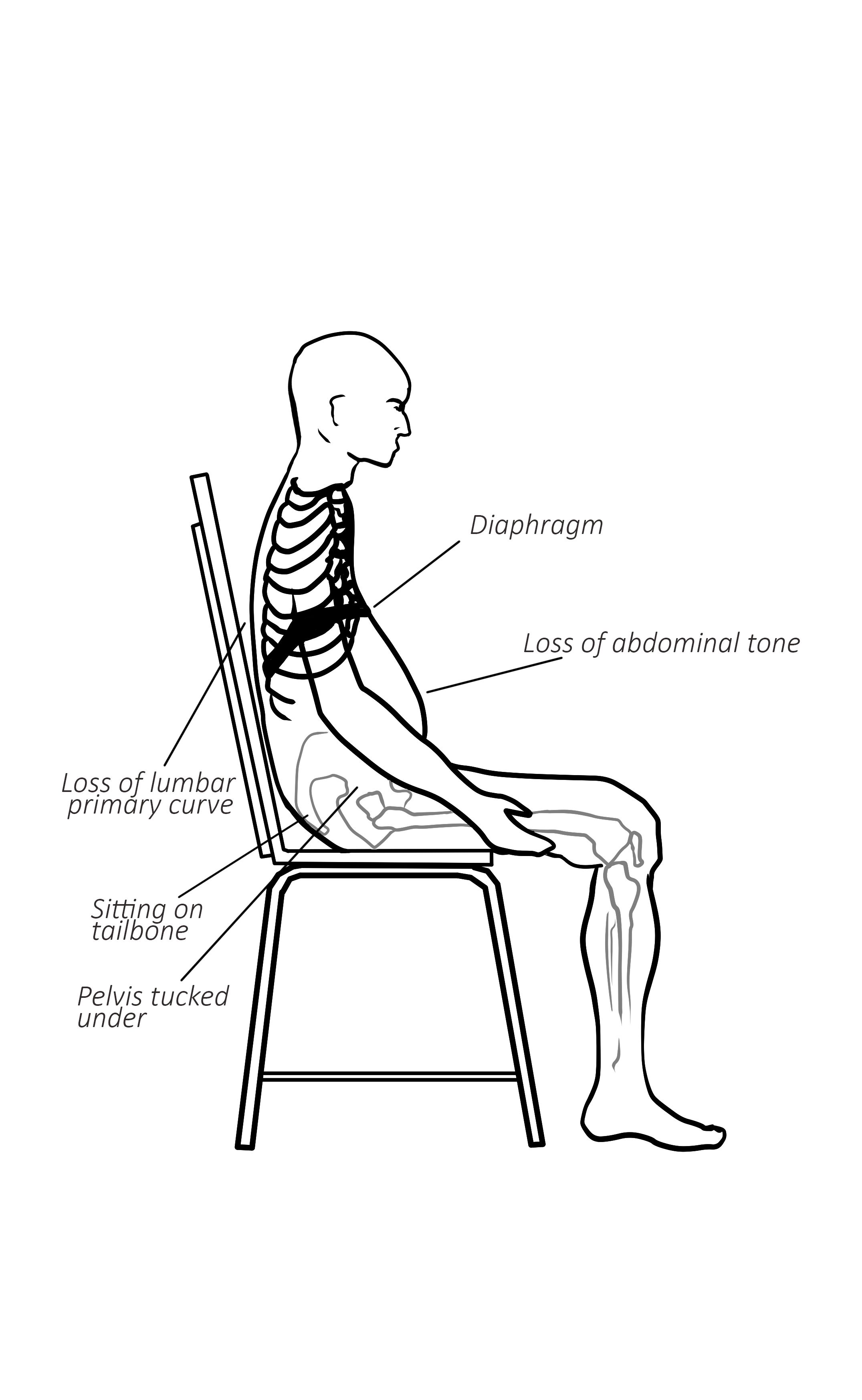
Sacrum as keystone
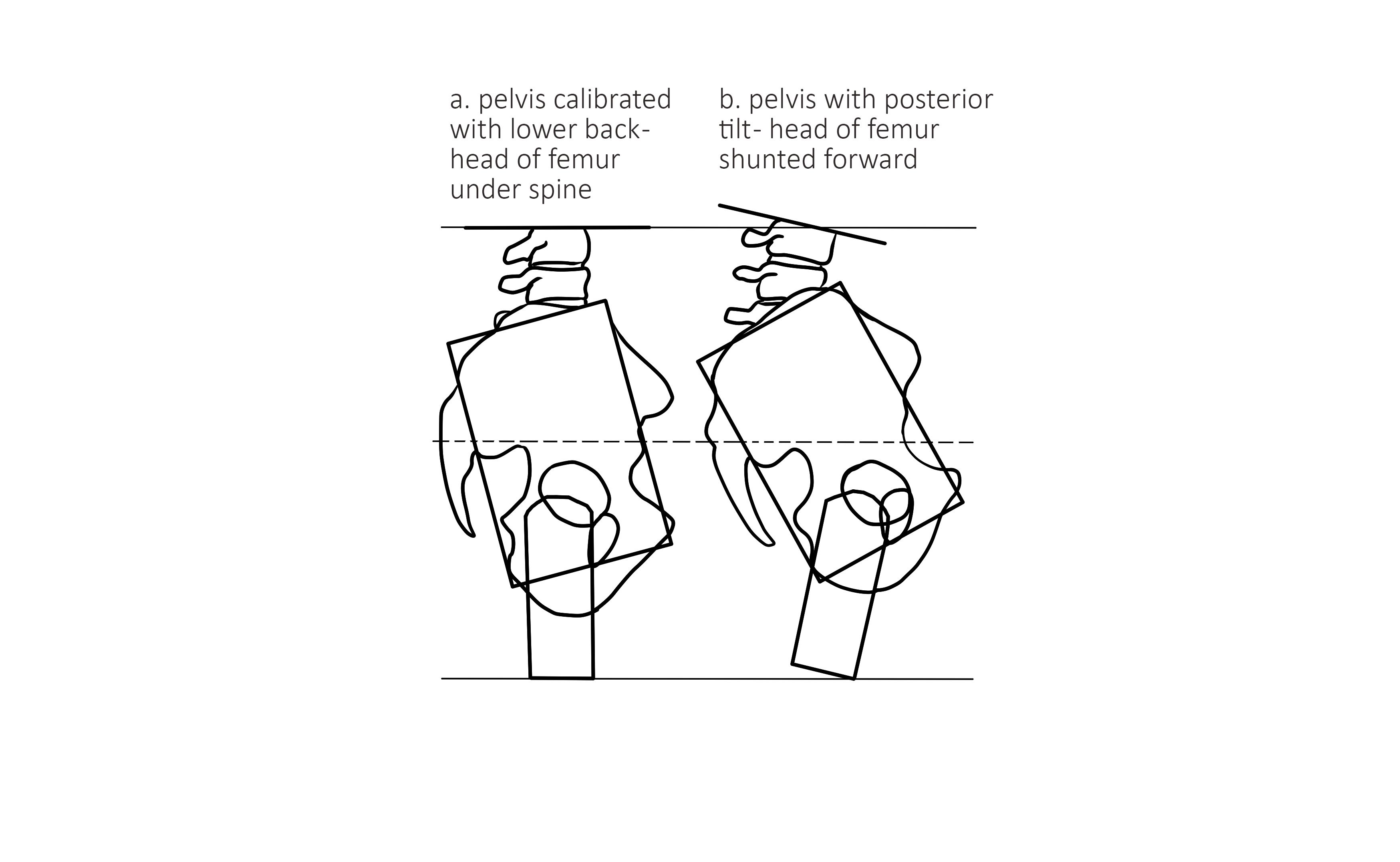
The sacrum, the lowest, fused vertebrae at the back of the pelvis, needs a 30-degree angle for its supportive keystone design in the lower back primary curve. If flat (vertical), the top of the thigh bone gets moved back as the pelvis shunts forwards (fig. above). This upsets the most efficient posture: ears above shoulders, above hips, above the head of the thighbone, above the ankle.
The root of many problems
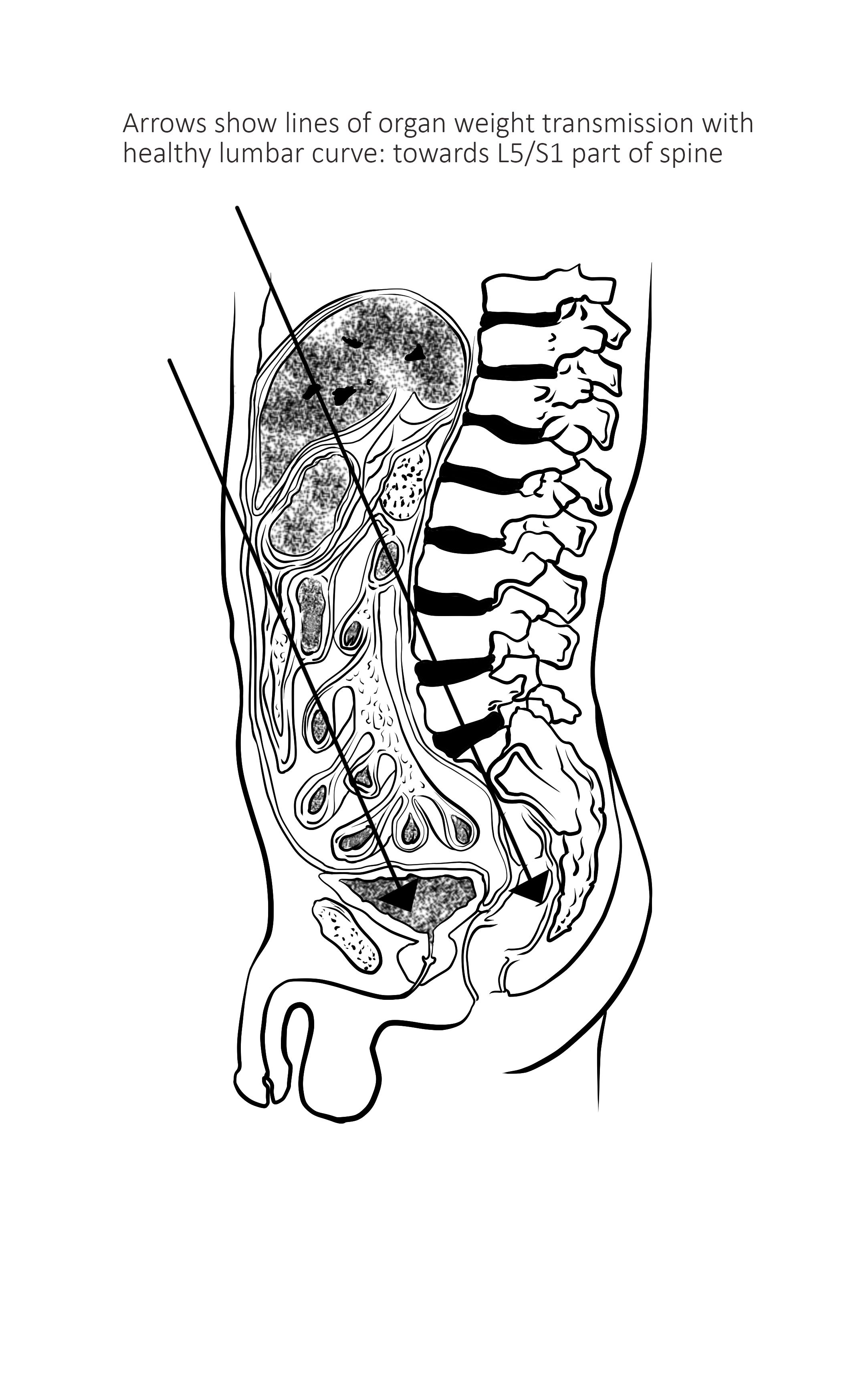
So how you sit, and therefore stand, is well worth investigating if you suffer from lower back, reproductive or digestive issues.
Part of our S-shape spine design is to help support our pelvic and digestive organs, which unlike our four-legged friends, are vertically stacked. A healthy lower back curve means that these viscera are happily weighted against the lower back, rather than directed straight down (fig. left) towards the pelvic floor, which must then tense up, and subsequently weaken, to support them. This can send ripples of stress through the pelvic and digestive organs, creating tightness in the connective tissue, reproductive and digestive conditions, as well as the more obvious lower back issues
Sacroiliac issues
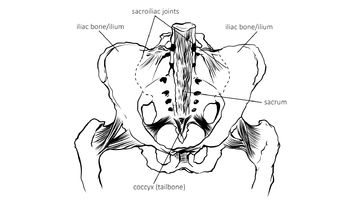 The hip joints and the sitting bones are directly underneath the sacroiliac (SI) joint, where the sacrum (the base of the spine) fuses with the pelvis. This is the root of many lower back issues; collapsing backwards into the pelvis strains this connection and can cause inflammation and instability. Especially if we tend to habitually sit cross-legged in the same direction, off-centre tendencies of the pelvis can create micro-tears in the SI joint ligaments. These can also become overstretched from injury, surgery, accidents, pregnancy or emotional holding in protective patterns. Sitting for long periods in the same position will exacerbate all of this.
The hip joints and the sitting bones are directly underneath the sacroiliac (SI) joint, where the sacrum (the base of the spine) fuses with the pelvis. This is the root of many lower back issues; collapsing backwards into the pelvis strains this connection and can cause inflammation and instability. Especially if we tend to habitually sit cross-legged in the same direction, off-centre tendencies of the pelvis can create micro-tears in the SI joint ligaments. These can also become overstretched from injury, surgery, accidents, pregnancy or emotional holding in protective patterns. Sitting for long periods in the same position will exacerbate all of this.
When it comes to the computer crunch…
While we might perceive sitting as inert and relaxing, because we are resting our legs, it is actually as dynamic a position as standing for the upper body. It is rare for a human with natural movement to stand still for any period of time equally on both legs - we would usually shift weight – and this is the same for sitting equally on both sitting bones. To do so is tiring, and so we tend to collapse into the lower back after a while.
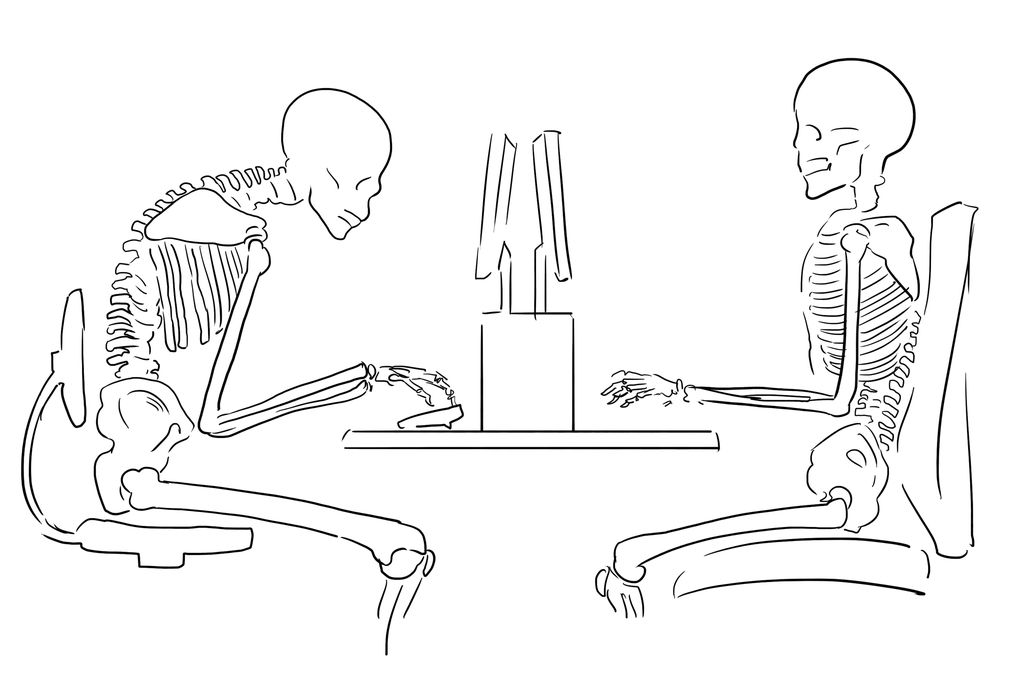
It is not unusual for the majority of a modern day to be spent hunched over a keyboard (the left example), and if this is not with conscious, supported upright posture (the right-hand side example), it can quickly descend into a regular hunch that can contribute to a collapsed standing posture, where we lift up from the ground ‘up the back and down the front’ rather than the more open, grounding and supportive ‘up the front and down the back’.
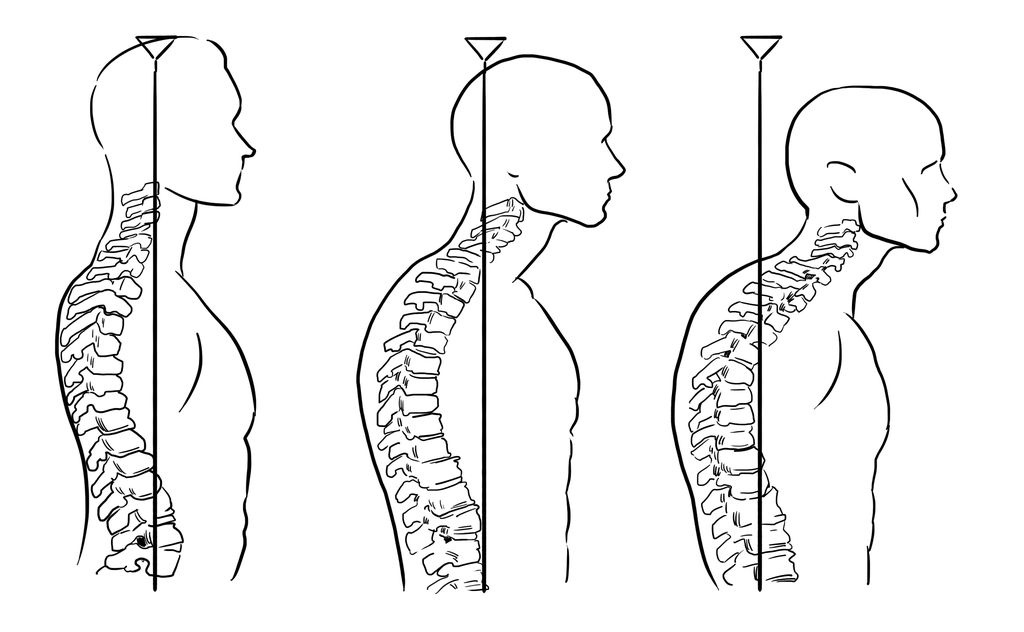
We can see here that the head can be pushed forwards of the spine and cause huge strain on the neck, partly from the forward angle and partly because the head becomes ‘heavier’ to hold up as it is further away from the centre of gravity. The pelvis will shift forward or back to counter this weight, adding to lower back issues.
While paying attention to sitting posture and consciously lifting up through the front spine is definitely important, getting up and moving around is even better. When we do this, we move and hydrate tissues, support circulation and raise our metabolism. When working, moving your eyes rather than your head to look down and/or forward can also help avoid strain in the neck.
4 more conscious things to do on a chair than sitting
A seated yoga practice on a chair can help inform how we bring awareness to sitting and also create the movement in the spine and pelvis that can become limited from chair-sitting.
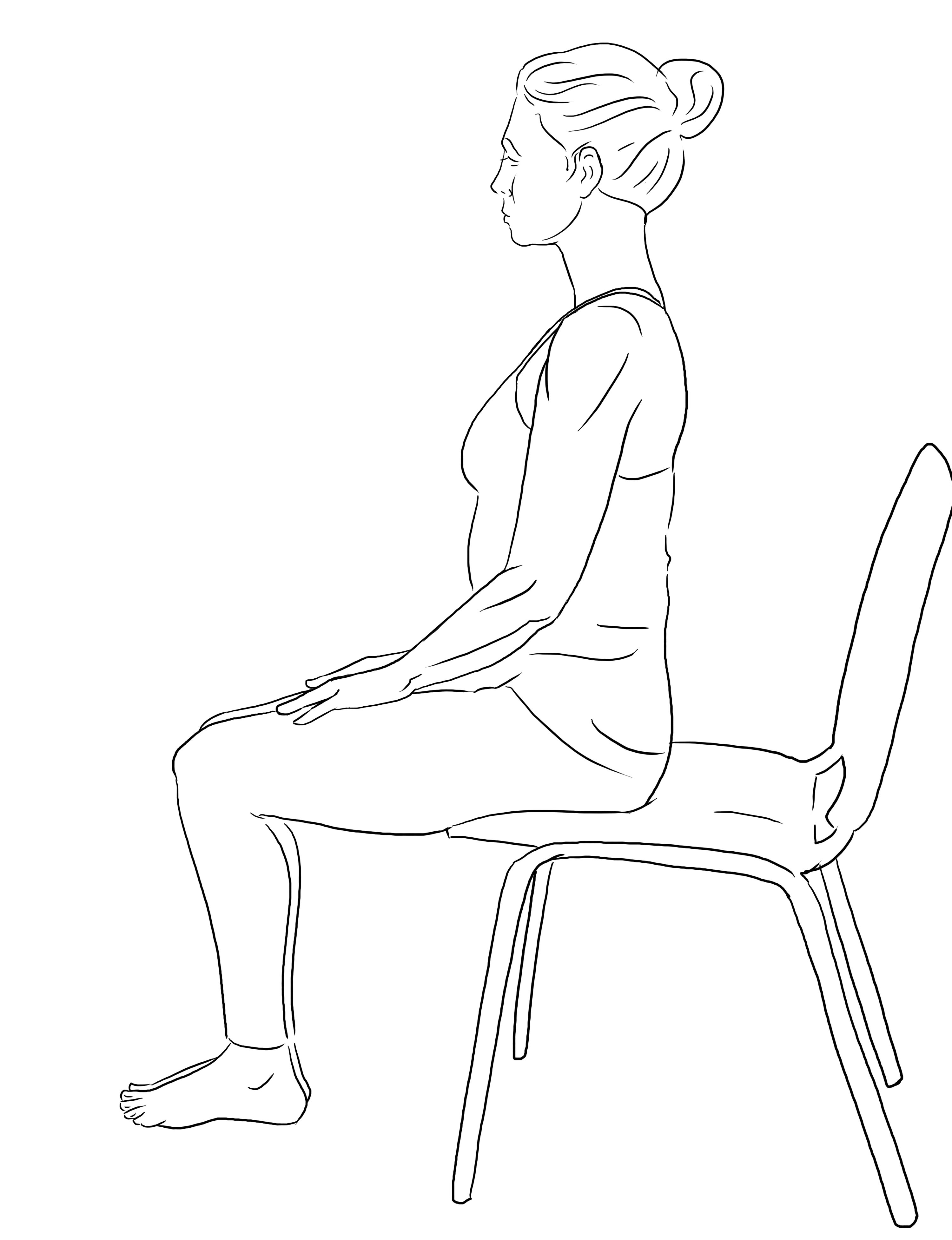
1. Sit forwards
- Sit to the front of the seat with heels under the knees and feet grounded to sit up from the sitting bones.
- Ears are above shoulders, shoulders above hips; with natural curves in place.
The lift and space that comes through the back of the skull – as if it were ‘floating’ above the tailbone – is the ideal upright seated position. Here the brainstem also stays awake; when we collapse down, we can become more mentally ‘dull’.
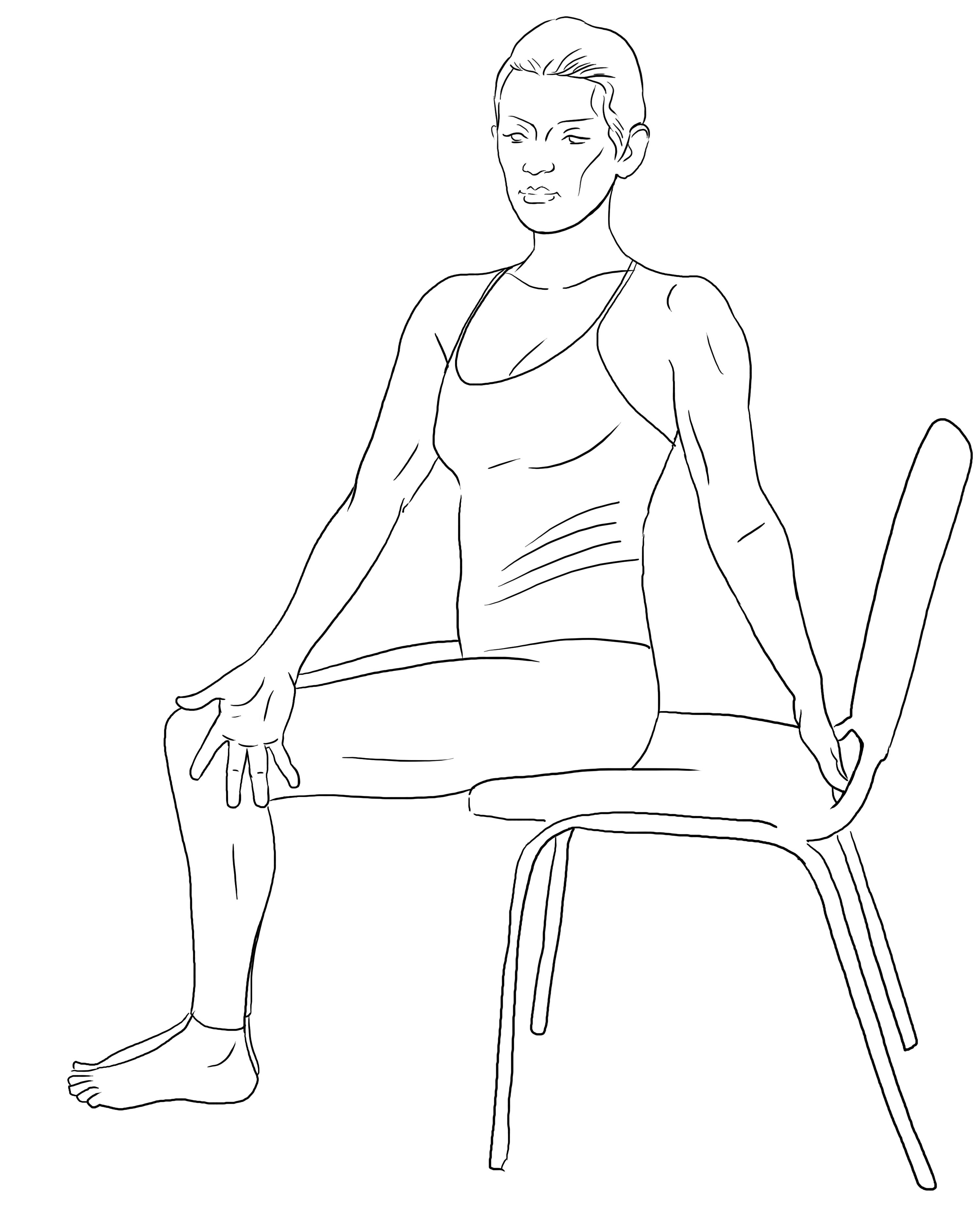
- Make space through the spine
- On and exhale, turn to the right.
- Take one hand to the back of the chair seat and the other to the outside of the front thigh to open the collarbones and drop the shoulders.
Creating space between the discs of the spine allows us to twist without compression. Regularly turning around the axis of the spine helps to counter the tension in torso fascia that contributes to back pain and digestive issues.
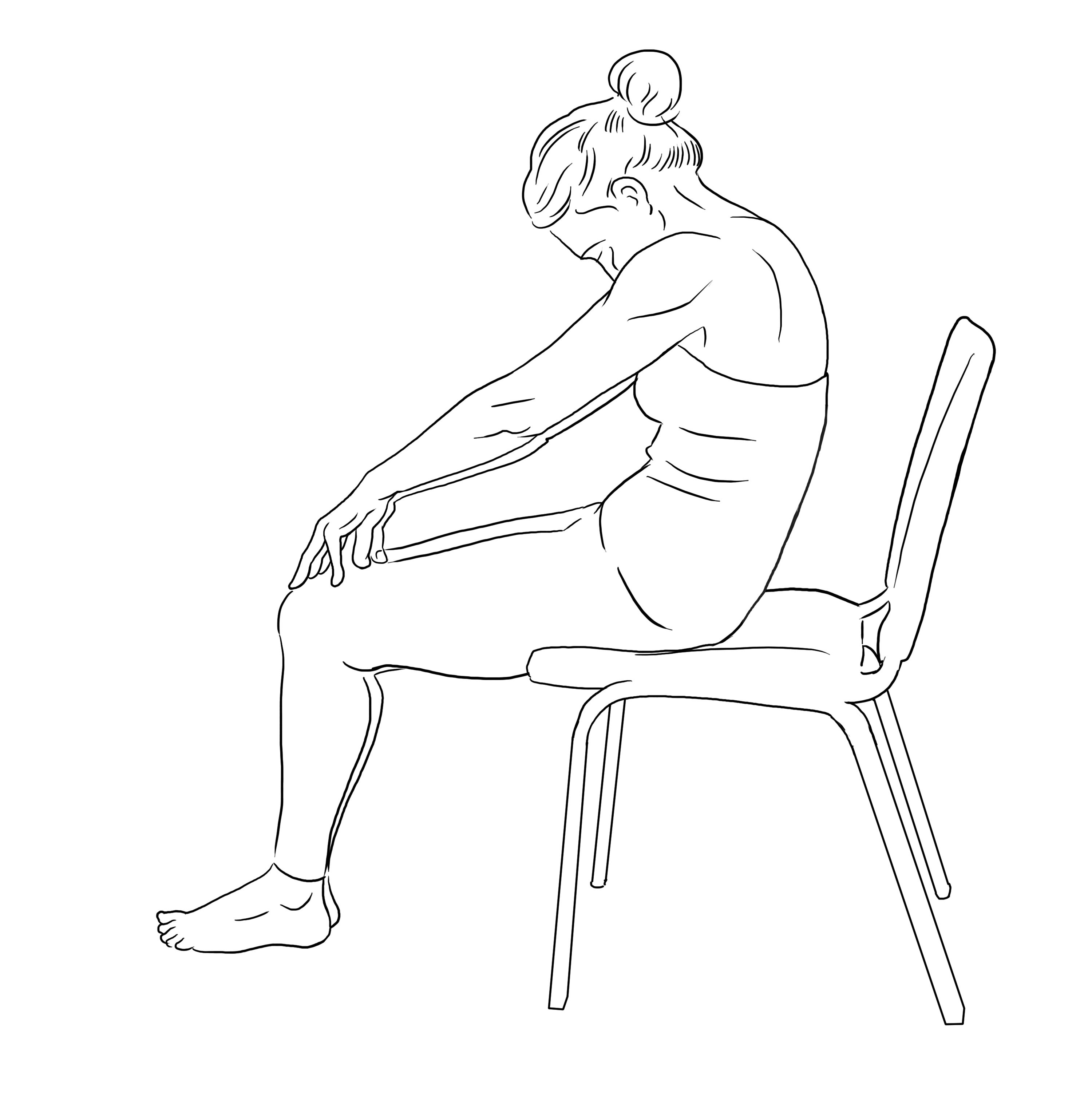
- Find your curves
- Inhale to arch the back to open the front body and chest.
- Exhale to curl in to open the back body and consciously move into the pattern of ‘collapse’ to free that tension.
- Move between the two pelvic positions to create awareness of sitting bones on the chair and where the balance of a happy lower back curve lies.
Pelvic tilts here help remind us where the lower back can ideally sit.
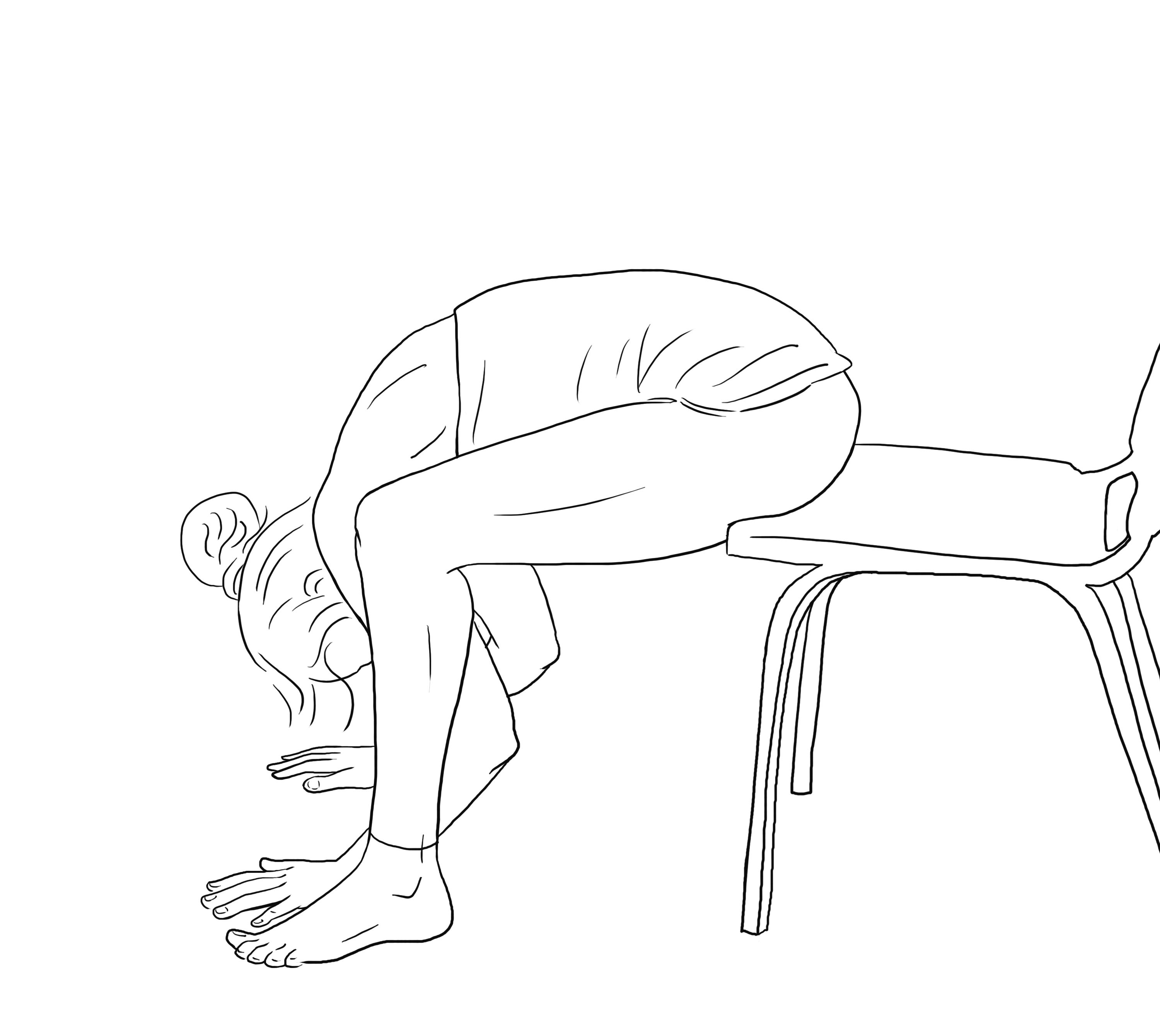
- Release spinal tension
- Open legs wider and drop torso down, either head below knees or just elbows to thighs if any dizziness or unease comes from the lower head position.
- Breathe fully here to allow the nervous system to calm.
This rests and relieves a tight, bound-up back in a chair version of Balasana (child pose).
Meditation posture
What happens when you sit for meditation directly on the ground? Probably, like most people, the postural habits that come from chair sitting mean you collapse into your pelvis (below left),and lift your chin (below right), which compresses around the belly and neck, but there are several things you can do to find more uplift and avoid neck and shoulder pain.
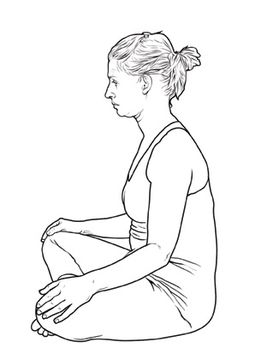
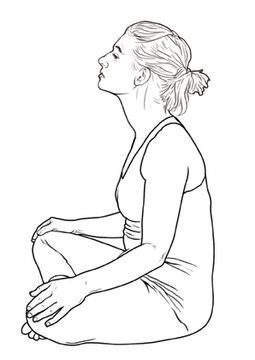 Positions to play with for meditation:
Positions to play with for meditation:
Here are some ways to nurture the natural S-shape spine that create the expanded inner landscape that meditation invites:
- Use support: One (or usually two) yoga blocks or folded blankets under the sitting bones allows more uplift – the feeling of lifting the abdominal contents out of the pelvis with natural lengthening between the ribs and the pelvis. This may be cross-legged if knees and hips allow.
- Vary your leg position: Many people are more comfortable with legs bent back in Virasana (Hero Pose) with support (block/s, blanket/s, a meditation cushion or bolster).
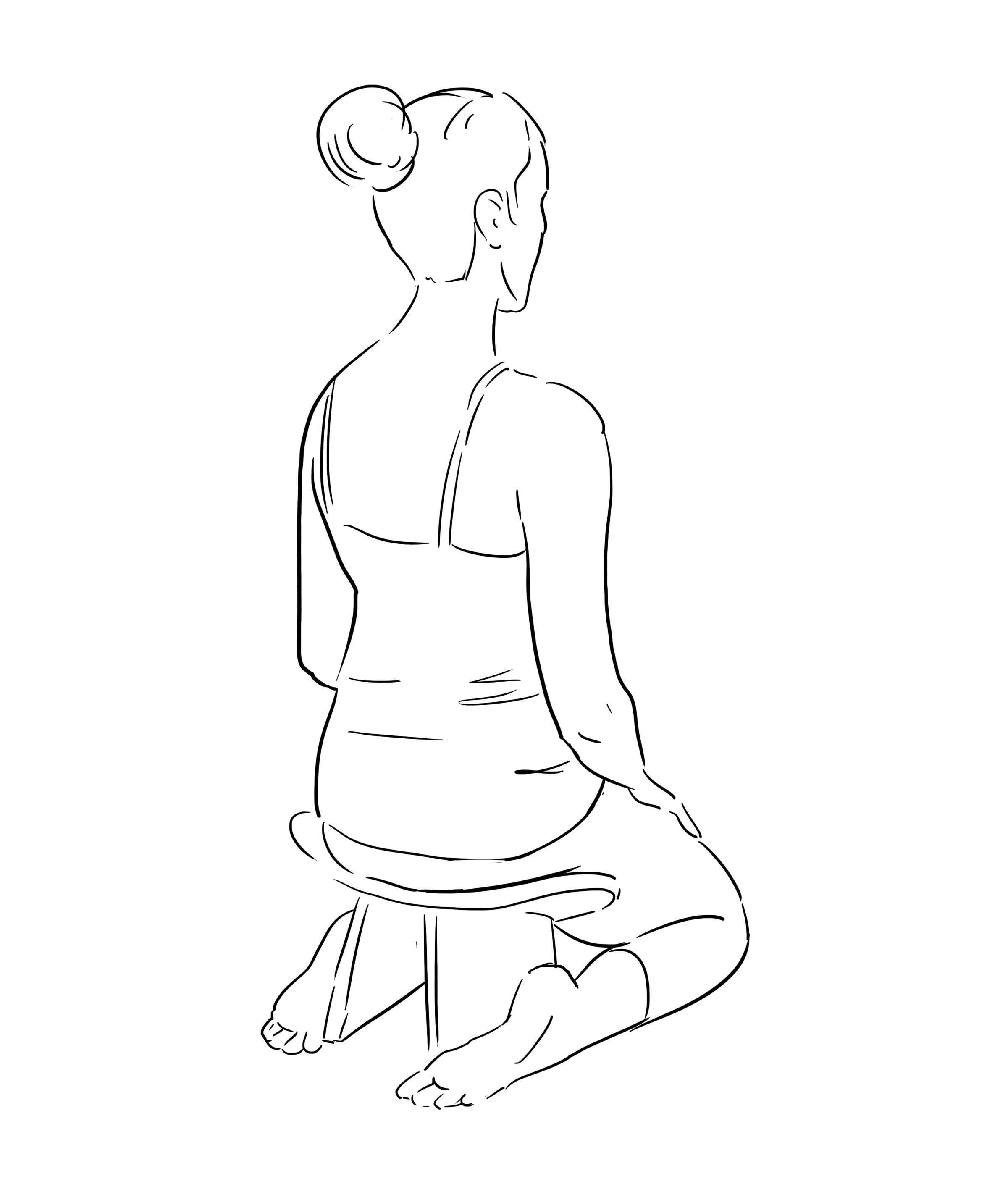
3. Meditation stool: A dedicated meditation stool could be a useful investment as it raises the hips higher and tilts the pelvis forwards. It can be used for more than meditation too.
Resetting the results of sedentary habits
Because collapsed posture can become a set state, especially for those sitting for hours on chairs, when we create more length in the front body and begin contracting overstretched muscles in the back body that have been habitually over-stretched, this can feel strong at the beginning and even sore after practicing. You might feel quite tired from sitting up onto a block as your muscles are not used to holding this position.
Through inviting more conscious, healthy body patterns for habitual sitting within yoga or movement classes, we are promoting the expansion of awareness to how people sit at work or on the sofa. It is common for people to go through ‘growing pains’ during this reconfiguration; releasing held habits (samskaras) can be an uncomfortable and challenging process. Staying with the breath being slow and easeful will help to release this tension in the body as well as signalling to the nervous system that it’s safe to let go. Ultimately, this deeper listening and responding to the body leads to greater freedom of movement, more energy and has long-term health benefits.
See also: Keep on moving
[1] (British J Sports Med. 2017;51(10) https://pubmed.ncbi.nlm.nih.gov/27153869/
[2] (Lancet.2016;388(10051),1302–1310) https://pubmed.ncbi.nlm.nih.gov/27475271/
[3] https://www.washingtonpost.com/lifestyle/wellness/standing-desks-boost-productivity-not-just-health-study-finds/2016/05/31/b7948390-2358-11e6-8690-f14ca9de2972_story.html
[4] (PLoS One. 2015;10(3),e0121159) https://pubmed.ncbi.nlm.nih.gov/25806808/
Visit Whole Health with Charlotte for online classes, meditations, guest classes, Natural Health Webinars, supplement discounts and more.




